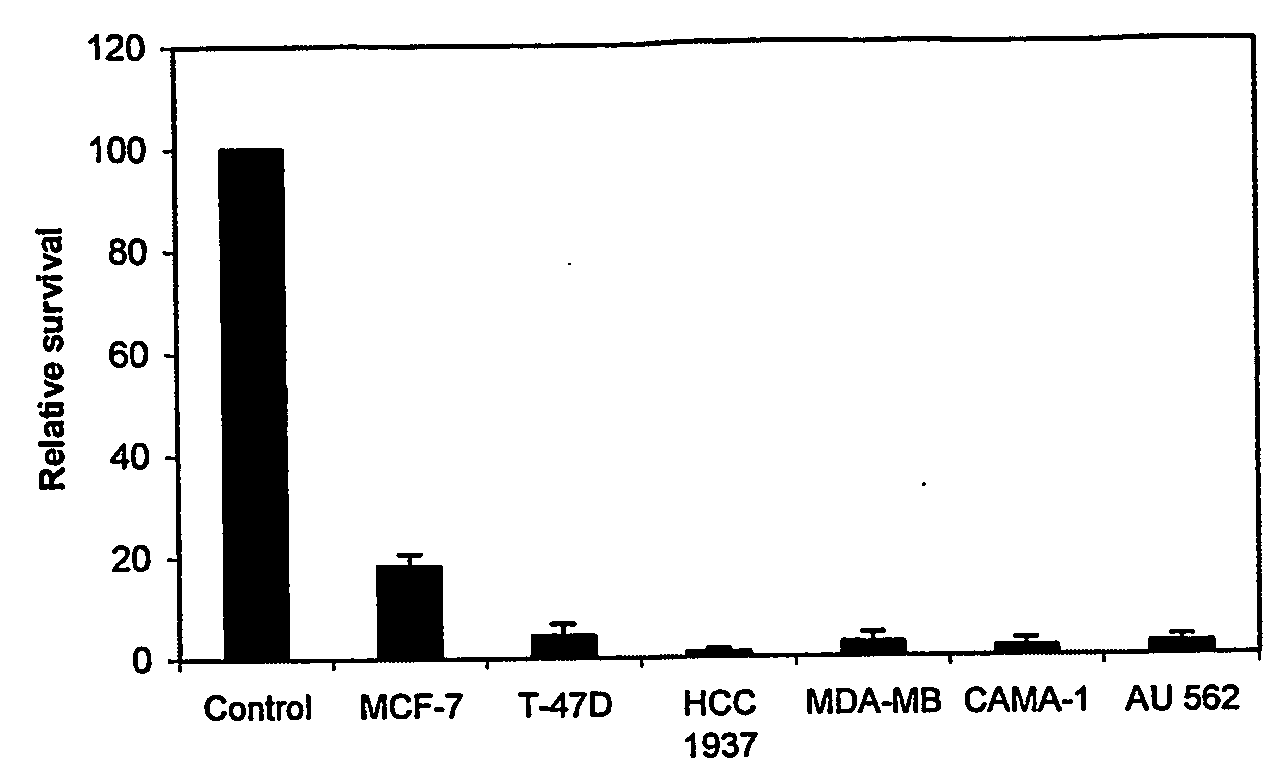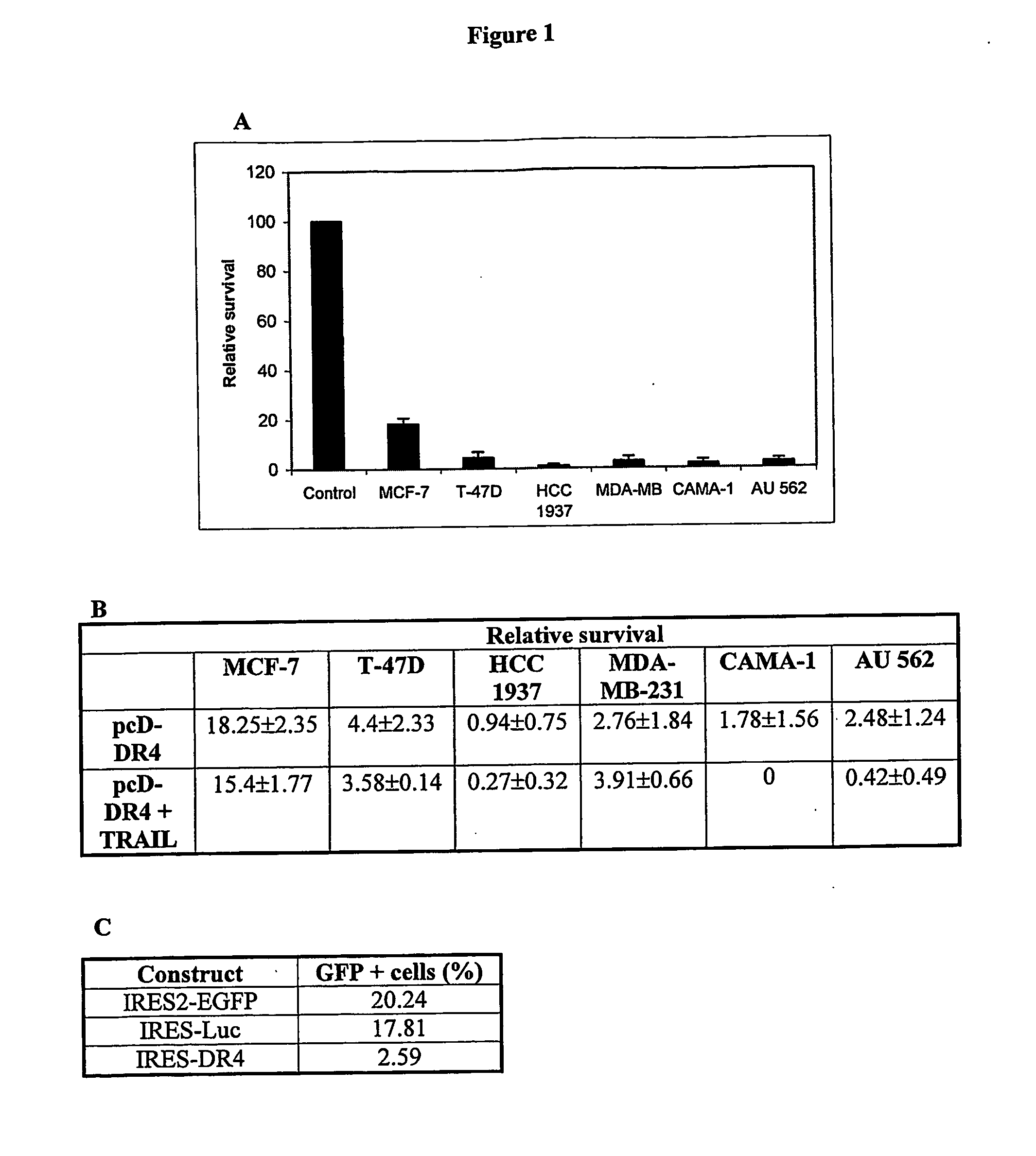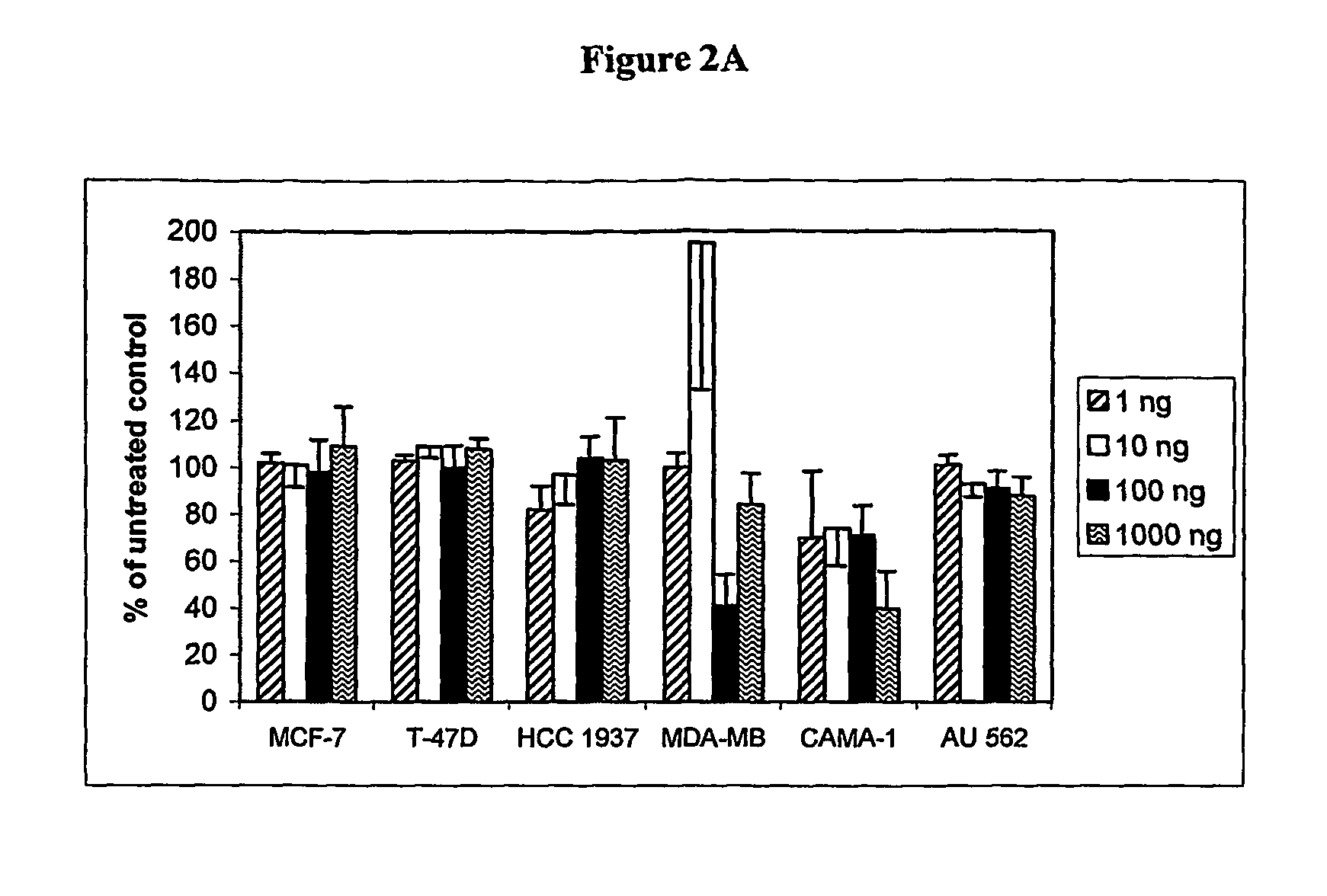Methods And Compositions For Combinatorial Approaches To Cancer Gene Therapy
a technology of combinatorial approaches and cancer gene therapy, applied in the manufacture of genetic therapy compositions, drug compositions, viruses, etc., can solve the problems of scarce effective molecular therapies for cancer, and achieve the effect of high activity and high activity
- Summary
- Abstract
- Description
- Claims
- Application Information
AI Technical Summary
Problems solved by technology
Method used
Image
Examples
examples
Example 1 DR4 Studies
[0122]Cell lines and reagents. Human breast cancer cell lines MCF-7, CAMA-1, HCC 1937, MDA-MB-231, T-47D and AU 562 were obtained from American Type Culture Collection (ATCC). Cells were maintained in RPMI 1640 (T47D, AU-562 and HCC 1937), A-MEM (MCF-7 and CAMA-1) or Leibovitz's-15 (MDA-MB-231) medium with 10% FBS, penicillin (100 U / ml) and streptomycin (100 μg / ml) at 37° C. Except for MDA-MB-231, which did not require CO2 supplementation, all cell lines were grown in humidified atmosphere with 5% CO2. These six cell lines differ in expression of genes relevant to pathogenesis and prognosis of disease, such as the estrogen receptor (ER) expressed in MCF-7, T-47D and CAMA-1 cells; Her2 / neu, expressed in T-47D and AU 562 cells and possibly in CAMA-1 cells; mutated p53 tumor suppressor, detected in all of these cell lines except MCF-7; and BRCA1 mutations, expressed in HCC 1937 cells. There is also a moderate c-myc amplification in CAMA-1 cells and MCF-7 cells are ...
example 2
tBid Studies
[0139]In this study, tumoricidal activity of tBid and the ability of survivin, hTERT and Muc1 promoters to direct tBid expression in breast cancer cells were evaluated.
[0140]Cell lines and reagents. Human breast cancer-cell lines MCF-7, CAMA-1, HCC 1937, MDA-MB-231, T-47D and AU 562 were obtained from the American Type Culture Collection (ATCC). Cells were maintained in RPMI 1640 (T-47D, AU-562 and HCC 1937), α-MEM (MCF-7 and CAMA-1) or Leibovitz's-L15 (MDA-MB-231) medium with 10% FBS, penicillin (100 U / ml) and streptomycin (100 μg / ml) at 37° C. Except for MDA-MB-231, which did not require CO2 supplementation, all cell lines were grown in humidified atmosphere with 5% CO2.
[0141]Reagents used in the study were obtained from the following companies: FuGENE 6 Transfection Reagent—Roche Applied Science (Indianapolis, Ind.); Dual-Luciferase Reporter Assay System—Promega (Madison, Wis.); Luminescent beta-gal detection kit—BD Biosciences Clontech (Palo Alto, Calif.); Anti-survi...
example 3
Targeting Cells with Loss of Functional p53
[0168]Assembling the construct for targeting cells with loss of functional p53. A construct was prepared having the following order of elements:
[0169]Lox-poly-A-“killer gene”-promoter Lox-mCre gene-p53-RE
[0170]As described herein, targeting of “killer genes” to cancer cells with loss of functional p53 involves assembling a construct where modified Cre gene is placed under the control of p53 response element and a “killer” or surrogate “killer” gene is positioned between two Lox sites.
[0171]Cloning and selection of an efficient p53 response element. The first step was to obtain a p53 response element with low background activity and high inducibility by wild type p53 to selectively express Cre recombinase in p53 positive cells. To achieve this goal, pGL3 basic vector (Promega) was modified by cloning a synthetic TATA box upstream of the luciferase gene (pGL3-Bm). Oligonucleotides containing 2 copies of consensus p53 binding site (53C series)...
PUM
| Property | Measurement | Unit |
|---|---|---|
| concentration | aaaaa | aaaaa |
| pH | aaaaa | aaaaa |
| temperature | aaaaa | aaaaa |
Abstract
Description
Claims
Application Information
 Login to View More
Login to View More - R&D
- Intellectual Property
- Life Sciences
- Materials
- Tech Scout
- Unparalleled Data Quality
- Higher Quality Content
- 60% Fewer Hallucinations
Browse by: Latest US Patents, China's latest patents, Technical Efficacy Thesaurus, Application Domain, Technology Topic, Popular Technical Reports.
© 2025 PatSnap. All rights reserved.Legal|Privacy policy|Modern Slavery Act Transparency Statement|Sitemap|About US| Contact US: help@patsnap.com



